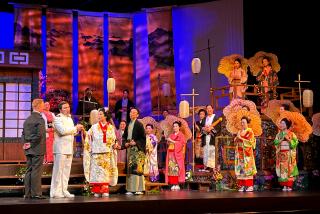Richard Montoya takes L.A. tale âWater & Powerâ from stage to screen
Richard Montoya keeps a mental library of depictions of L.A. gleaned from âChinatown,â âRepo Man,â âMulholland Drive,â the novels of James Ellroy, and other pop-culture texts.
So when he began adapting his neo-noir stage drama âWater & Powerâ for the screen in 2007, as a Sundance Institute film fellow, it was natural for Montoya to seek advice from Walter Mosley, author of Angeleno classics such as âDevil In a Blue Dress,â and one of Montoyaâs literary idols.
Montoya quickly learned that he had a lot to learn about filmmaking.
âIt was complete tough love,â recalls Montoya, an actor, playwright and member of the Chicano comedy-theater ensemble Culture Clash. âHe [Mosley] throws my script on the table, and he says, âThis is still a play, itâs not a film yet.â
CRITICSâ PICKS: What to watch, where to go, what to eat
Was he right? âAbsolutely,â Montoya says.
Six years and $600,000 later, âWater & Powerâ is being screened Saturday and Sunday as part of the revived L.A. Latino International Film Festival (LALIFF). The movie was adapted and directed by Montoya from the Culture Clash stage play that premiered in 2006 at the Mark Taper Forum.
âI know for a fact there are people that saw the play three times, four times,â says Marlene Dermer, LALIFFâs executive director and co-founder. Montoya, she adds, âis a multi-faceted artistâ whom âmore people need to know.â
The film doesnât yet have a distributor. What it does have is a lyrically two-fisted, tragi-comic vision of Los Angeles centered on the cityâs Latino-centric Eastside, a region that movies largely ignore with rare exceptions such as âZoot Suit,â âStand and Deliverâ and âAmerican Me.â
PHOTOS: Best in theater for 2012
âI often think that its grandfather is âZoot Suit,â its father is âAmerican Me,â and this is the son,â Montoya says of his feature directing debut. âThereâs a lineage there that I can only hope for.â
If those earlier movies were, albeit in very different ways, about L.A. Latinos aspiring to equality and opportunity, âWater & Powerâ is about what happens once that influence is actually acquired. The play was first produced soon after L.A. had voted in its first Latino mayor, Antonio Villaraigosa, in a century. Sometime this year, according to U.S. Census estimates, Latinos will become the cityâs dominant ethno-cultural group.
âThe film hopes to be a kind of a cautionary tale with how weâre going to proceed in this city and how are we going to deal with each other,â Montoya says.
The movie tells the story of the Garcia twins, nicknamed Water and Power by their father, a DWP laborer who coaches his sons to fulfill their worldly ambitions but keep faith with their Eastside origins. Gilbert, a.k.a. Water (played in the film by Enrique Murciano), grows up to be a state senator who stakes his integrity on pushing a green-space bill for the congested Eastside. Gabriel (Nicholas Gonzalez) grows up to be a cop struggling to reconcile his personal and professional obligations with societyâs situational ethics.
CHEAT SHEET: Fall arts preview
Shot in 12 nights in September 2012, the movie takes place in the course of one moody, rain-swept evening that transports viewers to a motel room, a police station, a strip club and other bluesy haunts. By the time dawn breaks, sibling loyalty and civic idealism have collided with harsher realities: greed, racism, corruption, violence and â the most self-immolating force of all â noble intentions.
Aficionados of L.A. theater will spot many familiar faces among the cast including, in a fleeting role, the late Lupe Ontiveros in her final screen performance. Clancy Brown plays the smoothly menacing powerbroker called the Fixer. Roger Guenveur Smith is a cop who in one scene confronts the movieâs burly Chicano homeboy narrator, Norte/Sur, portrayed by Emilio Rivera, whose television roles include Marcus Ălvarez in the FX drama âSons of Anarchy.â
Rivera, who portrayed a different character in the stage version of âWater & Power,â said that as the film shoot progressed, he watched it transform from a creature of the stage to a creature of the screen.
âWhen I first saw the first cut, it looked like they put together a play,â Rivera said during a recent interview at the Eastside Luv bar. A key challenge in making the conversion from play to film, Rivera said, was to âbring it down and make it real.â
PHOTOS: LA Opera through the years
Smith, who directed one of Culture Clashâs earliest shows, âRadio Mambo,â said he thought it would be crucial for the film âWater & Powerâ to preserve the âpsychic claustrophobiaâ of the stage play.
âIf anything, itâs been enhanced,â Smith says, âbecause those intimate moments are something that really takes the audience imaginatively, and work in ways in which a stage play could never work.â
Regardless of how the movie fares with critics and audiences, it may already have captured an important moment in L.A.âs historical and cinematic evolution. At a screening, Howard Rodman, a USC professor and an artistic director of the Sundance Institute Screenwriting Lab, said that with âWater & Power,â Montoya had âturned the camera around 180 degreesâ on L.A. and its long arc of filmic representation.
âHe challenged us to imagine that Los Angeles is a Hispanic city,â Rodman said. âHe challenged us to see what is in front of our eyes that we never see.â
MORE
PHOTOS: Hollywood stars on stage
CHEAT SHEET: Fall Arts Preview
PHOTOS: Arts and culture in pictures
More to Read
Only good movies
Get the Indie Focus newsletter, Mark Olsen's weekly guide to the world of cinema.
You may occasionally receive promotional content from the Los Angeles Times.











